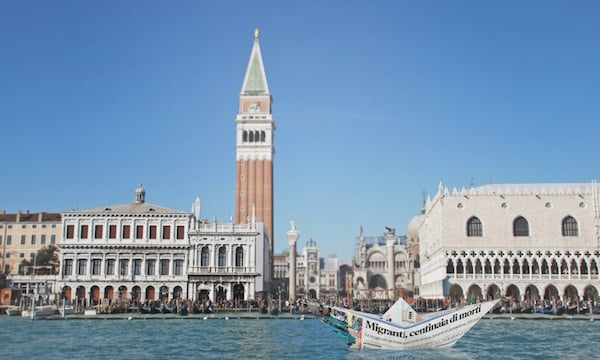Art & Exhibitions
Why Does Vik Muniz’s Giant Paper Boat for the Venice Biennale Trivialize Europe’s Migrant Crisis?
Has Muniz bitten off more than he could chew?

Photo via: My Art Guides
Has Muniz bitten off more than he could chew?

Lorena Muñoz-Alonso

When the 2015 Venice Biennale opens on May 9, one of the accompanying public artworks that is sure to draw a lot of attention will be Vik Muniz’s Lampedusa—a 45 feet paper boat that will precariously sail the canals, alongside yachts, gondolas, and vaporettos bringing the mega-rich, the tourists, and the art lovers to their destinations (see The 2015 Venice Biennale List of Artists Is Out—See Our Exclusive).
The acclaimed Brazilian artist—who has participated in a spate of socially-engaged projects (see Vik Muniz Builds Favela Art School for Brazilian Children and Artists Help Raise $7.5 Billion for Global Vaccination Campaign)—created this work in response to the tragedy that unfolded in October 2013, when a boat carrying migrants from Libya capsized off the Italian island of Lampedusa, leaving up to 360 dead.
The wooden structure of Muniz’s Lampedusa was fabricated by expert Venetian artisans. It is emblazoned with a giant reproduction of an Italian newspaper reporting on the tragedy.
Although addressing an ongoing crisis, Muniz’s work has been rendered even more poignant by last Sunday’s tragic boat disaster just off the Libyan coast, thought to have killed up to 950 migrants from Africa, including 100 children, in a desperate bid to reach Italy.
Some Italian commentators have seen Muniz’s artwork as an effective memento of this humanitarian crisis, as well as a powerful reminder of Italy’s refusal to acknowledge its responsibility in the migrant crisis. “[The issue is] A conversation that Italy has never considered particularly, as if the question of countries disintegrating and fleeing was not our business,” a journalist writes in Exibart.
However, for others, Muniz’s Venice piece falls short. Jonathan Jones from the Guardian even goes as far as to allude that the artist might be trivializing a tragic humanitarian and political crisis.
“Will it be a powerful or in any way adequate artistic response to this vile betrayal of common humanity? An interview with Muniz online suggests not,” Jones writes about Muniz’s Lampedusa.
“Perhaps, in theory, it seemed reasonable to make a vaguely thought-provoking, ‘playful’ (as the interviewer puts it) piece about migration,” Jones argues. “But now the scale of our cruelty, the true consequences of all the rhetoric that dehumanizes migrants, have become so lethally clear, surely art on such a theme should be less equivocal, more angry,” he concludes.
But it’s perhaps Muniz’s own words that really downplay the tragedy. “The project is a metaphor for a vessel, something that saves you, takes you from one place to another,” Muniz says in the online interview.
“It’s not a criticism; it’s a platform. Once you’ve seen it and you’ve thought about it, you might have the need to discuss it … ,” Muniz offers.
Watch a rendering of the boat in the video below: